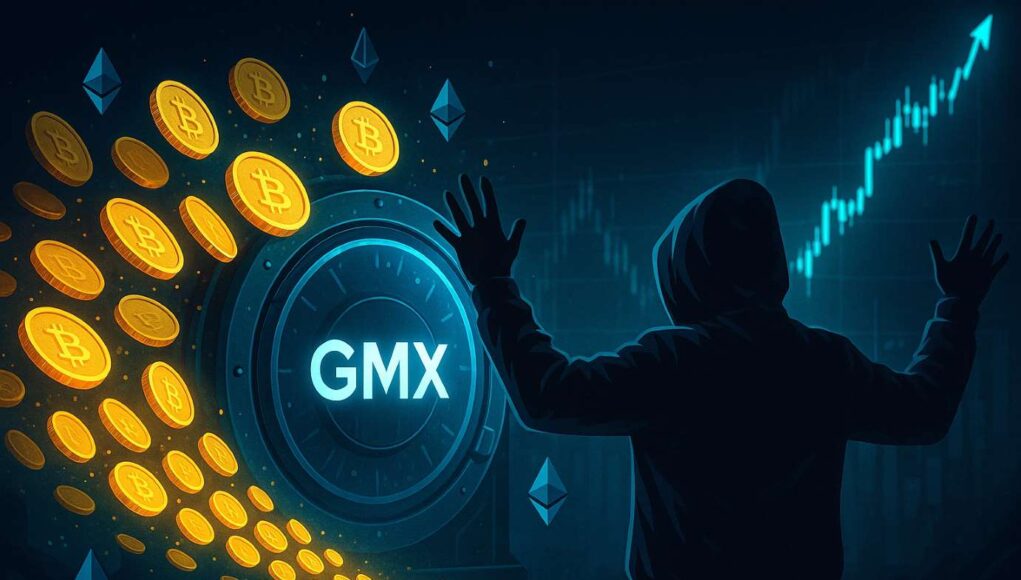In a dramatic turnaround for decentralized finance, the anonymous attacker behind the $42 million GMX hack has returned most of the stolen crypto assets. He struck a white-hat bounty deal with the protocol. The move not only reversed one of the largest DeFi exploits of 2025 but also triggered a swift recovery in the GMX token. It surged over 14% on the news. While the outcome restored investor confidence, it also reignited long-standing concerns over DeFi security and the reliability of bounty-based crisis management.
The Hack: How GMX Was Exploited
The GMX exploit took place earlier this week, targeting the decentralized perpetual exchange’s smart contract systems. The attacker exploited an oracle manipulation vulnerability, which allowed them to drain liquidity pools and manipulate pricing mechanisms. Over $42 million in various crypto assets were siphoned off before GMX was able to freeze key operations and contain the damage.
Security researchers later confirmed that flaws in the contract design and oracle integration were at the core of the breach. Similar issues have plagued multiple decentralized exchange hacks across the DeFi sector.
Hacker Turns White-Hat in $5M Bounty Deal
In a rare case of post-exploit diplomacy, the GMX hacker entered into communication with the protocol’s development team. He agreed to return $37 million worth of assets. In exchange, they were allowed to keep $5 million as part of a formal white-hat bounty deal. Such deals are controversial, but an increasingly common method of mitigating damage in DeFi exploits.
The GMX community largely supported the move, framing it as a pragmatic response in the absence of legal recourse in decentralized systems. The deal follows similar arrangements seen in the Euler, Curve, and Mango protocol breaches over the past year.
Tracing the Funds: 11,700 ETH in Motion
Blockchain analysts traced the stolen funds as they were converted into 11,700 ETH, distributed across multiple wallets. These movements triggered initial fears of asset laundering. However, soon after, the hacker returned the funds in a series of on-chain transactions, likely to wallets under the GMX team’s control.
On one hand, this act salvaged a significant portion of user and protocol funds. But it also showcased the role that crypto bounty negotiations can play in resolving high-stakes breaches without external enforcement mechanisms.
>>> Read more: CertiK May Report: Social Engineering Drives 2025 Crypto Losses
DeFi Security in the Spotlight
Despite the recovery, the incident casts a long shadow over the current state of DeFi security. The GMX exploit exposed once again how smart contract vulnerabilities and poorly protected oracle systems remain favorite targets for malicious actors. Security experts have warned that relying on ad hoc bounty settlements creates a dangerous precedent. They fear future hackers may view exploits as a negotiation tactic rather than a punishable offense.
The GMX hack also raised questions about the adequacy of protocol audits and the limitations of permissionless financial infrastructure.
GMX Token Rebounds on Return News
Initially, the breach sent shockwaves through the market. The swift return of funds and the publicized bounty deal then sparked a strong market reaction. The GMX token surged by over 16% within hours of the announcement, regaining much of the value lost during the panic. Analysts noted increased trading volume and renewed investor confidence, driven largely by the transparency of the team’s communication and the speed of the resolution.
This GMX price surge also signals a growing investor tolerance for DeFi volatility, provided incidents are resolved in favor of user funds.
Lessons Learned and Protocol Response
Following the exploit and resolution, the GMX team announced plans for a comprehensive protocol upgrade, including tighter oracle protections and third-party audits. Community members have also proposed the formalization of a structured DeFi attack response framework, possibly including pre-defined bounty tiers and third-party mediators.
While the GMX hack ended on a relatively positive note, it underscores the need for systemic change. As DeFi governance evolves, the sector must move beyond reactive measures and toward preventative architectures.
>>> Read more: Coinbase Data Breach: $20M Bounty After Ransom Demand
The GMX hack and its unexpected reversal are a defining moment in the evolving dynamics of decentralized finance. A white-hat hacker reversing a multimillion-dollar theft in exchange for a bounty may seem like a win. However, it also spotlights the fragility of the system. With the GMX token rebounding and the protocol poised for reform, the crypto world now grapples with a key question: Can DeFi scale on the back of trust, negotiation, and goodwill, or does it need new rules?
Readers’ frequently asked questions
How can I check if a DeFi protocol has active bug bounty programs?
To verify whether a DeFi protocol runs an active bug bounty program, check its documentation or GitHub repository for security policies. Platforms like Immunefi and HackenProof often list ongoing DeFi bounty programs and recent white-hat reports. Searching for “active DeFi bug bounty programs 2025” on aggregator sites can also reveal current security incentives.
What happens when crypto hackers return stolen funds?
When hackers return stolen assets, the protocol often offers a partial bounty as part of a white-hat agreement. This doesn’t always eliminate legal risk, but many decentralized projects prefer pragmatic solutions to recover funds. These “white-hat crypto deals” are becoming more common in high-profile DeFi hacks in 2025.
Are smart contract audits enough to prevent DeFi exploits?
Smart contract audits reduce risk but cannot guarantee complete safety. Many 2025 DeFi exploits occurred on audited code. To improve protection, users should look for protocols with multiple audits, on-chain monitoring, and real-time alert systems. Long-tail searches like “are smart contract audits safe enough in DeFi” reflect growing concern around this issue.
What Is In It For You? Action items you might want to consider
Evaluate DeFi protocols with active bounty programs before investing
Before committing funds to any project, check if it runs an ongoing white-hat or crypto bounty program. Platforms with transparent security incentives and public disclosures are more likely to handle exploits responsibly. Searches like “which DeFi protocols have active bug bounty programs 2025” can guide your due diligence.
Track how protocols publicly handle hacker negotiations
Monitor how teams respond to exploits. Whether they use on-chain messages, publish wallet deals, or involve third-party mediators. Projects that negotiate quickly and transparently may offer better post-attack protection. You can search for “how DeFi projects negotiate with hackers in 2025” to learn from past incidents.
Add DeFi audit layers to your personal investment checklist
Look for more than a badge. Investigate how recent the audit is, who conducted it, and whether the code has been retested after major updates. Searching for “how to verify smart contract audits DeFi 2025” gives you tools to protect yourself before the next exploit happens.











[…] >>> Read more: GMX Hack: Attacker Returns $37M in Deal After $42M Exploit […]